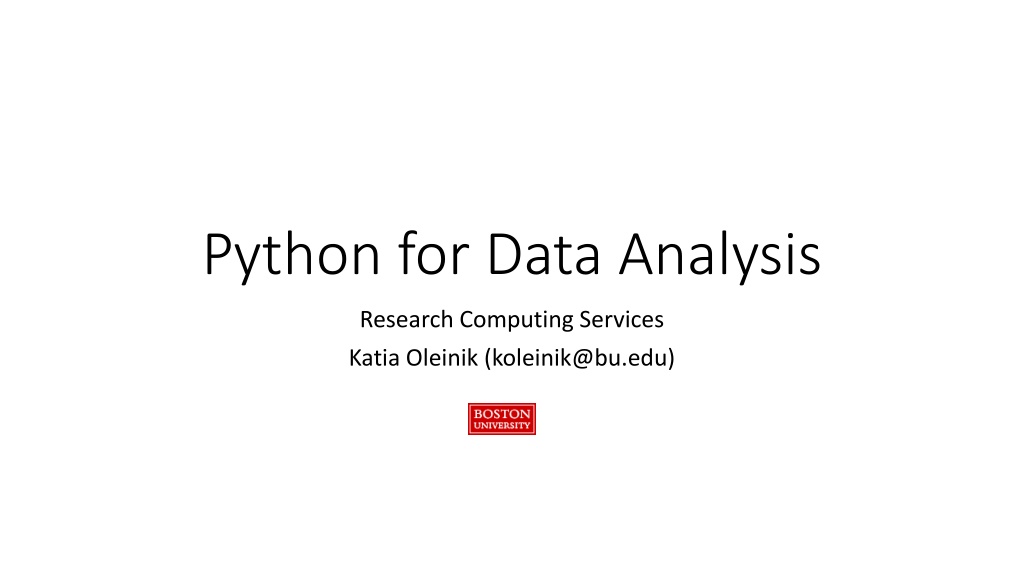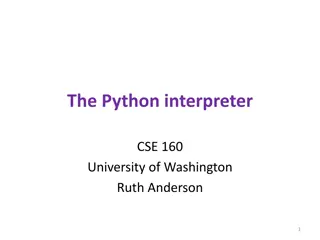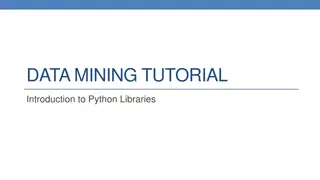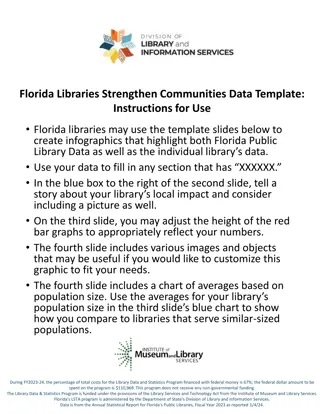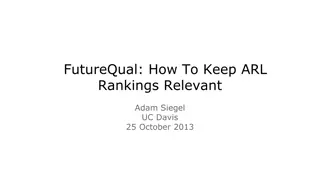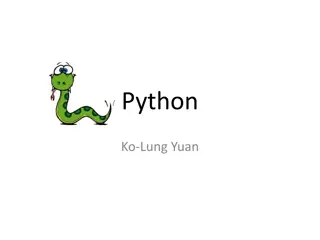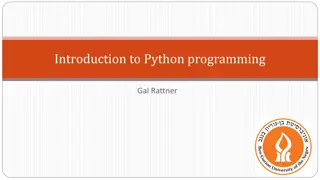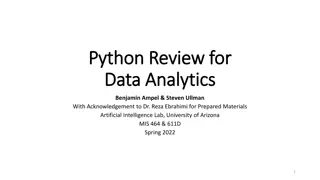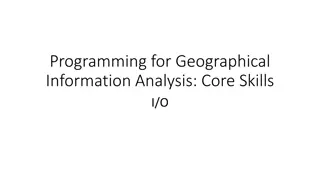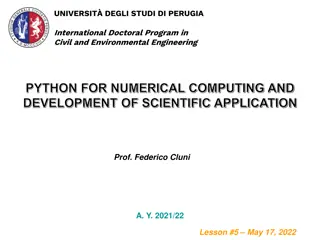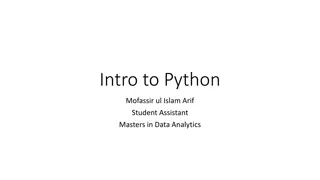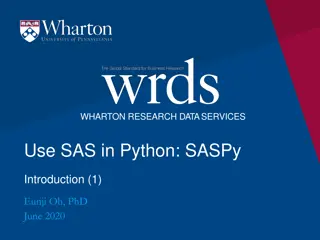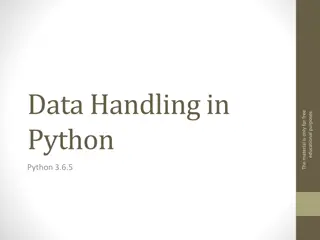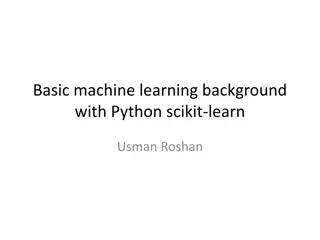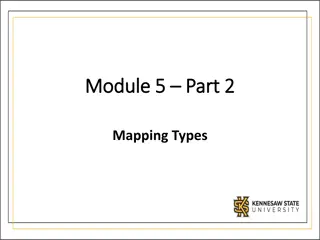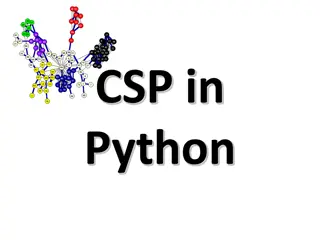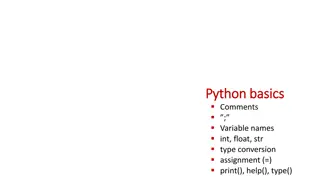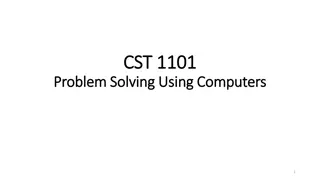Overview of Python Libraries for Data Science Research
Python Libraries for Data Science are essential for conducting research and analysis. This overview covers key libraries such as NumPy, SciPy, Pandas, and SciKit-Learn, which provide tools for data manipulation, statistical operations, and machine learning algorithms. These libraries enable data scientists to read, filter, manipulate, and visualize data efficiently, making it easier to derive insights and make informed decisions in research computing services.
Download Presentation

Please find below an Image/Link to download the presentation.
The content on the website is provided AS IS for your information and personal use only. It may not be sold, licensed, or shared on other websites without obtaining consent from the author. Download presentation by click this link. If you encounter any issues during the download, it is possible that the publisher has removed the file from their server.
E N D
Presentation Transcript
Python for Data Analysis Research Computing Services Katia Oleinik (koleinik@bu.edu)
Overview of Python Libraries for Data Scientists Tutorial Content Reading Data; Selecting and Filtering the Data; Data manipulation, sorting, grouping, rearranging Plotting the data Descriptive statistics Inferential statistics 2
Python Libraries for Data Science Many popular Python toolboxes/libraries: NumPy SciPy Pandas SciKit-Learn All these libraries are installed on the SCC Visualization libraries matplotlib Seaborn and many more 3
Python Libraries for Data Science NumPy: introduces objects for multidimensional arrays and matrices, as well as functions that allow to easily perform advanced mathematical and statistical operations on those objects provides vectorization of mathematical operations on arrays and matrices which significantly improves the performance many other python libraries are built on NumPy Link: http://www.numpy.org/ 4
Python Libraries for Data Science SciPy: collection of algorithms for linear algebra, differential equations, numerical integration, optimization, statistics and more part of SciPy Stack built on NumPy Link: https://www.scipy.org/scipylib/ 5
Python Libraries for Data Science Pandas: adds data structures and tools designed to work with table-like data (similar to Series and Data Frames in R) provides tools for data manipulation: reshaping, merging, sorting, slicing, aggregation etc. allows handling missing data Link: http://pandas.pydata.org/ 6
Python Libraries for Data Science SciKit-Learn: provides machine learning algorithms: classification, regression, clustering, model validation etc. built on NumPy, SciPy and matplotlib Link: http://scikit-learn.org/ 7
Python Libraries for Data Science matplotlib: python 2D plotting library which produces publication quality figures in a variety of hardcopy formats a set of functionalities similar to those of MATLAB line plots, scatter plots, barcharts, histograms, pie charts etc. relatively low-level; some effort needed to create advanced visualization Link: https://matplotlib.org/ 8
Python Libraries for Data Science Seaborn: based on matplotlib provides high level interface for drawing attractive statistical graphics Similar (in style) to the popular ggplot2 library in R Link: https://seaborn.pydata.org/ 9
Login to the Shared Computing Cluster Use your SCC login information if you have SCC account If you are using tutorial accounts see info on the blackboard Note: Your password will not be displayed while you enter it. 10
Selecting Python Version on the SCC # view available python versions on the SCC [scc1 ~] module avail python # load python 3 version [scc1 ~] module load python/3.6.2 11
Download tutorial notebook # On the Shared Computing Cluster [scc1 ~] cp /project/scv/examples/python/data_analysis/dataScience.ipynb . # On a local computer save the link: http://rcs.bu.edu/examples/python/data_analysis/dataScience.ipynb 12
Start Jupyter nootebook # On the Shared Computing Cluster [scc1 ~] jupyter notebook 13
Loading Python Libraries #Import Python Libraries import numpy as np import scipy as sp import pandas as pd import matplotlib as mpl import seaborn as sns In [ ]: Press Shift+Enter to execute the jupyter cell 14
Reading data using pandas #Read csv file df = pd.read_csv("http://rcs.bu.edu/examples/python/data_analysis/Salaries.csv") In [ ]: Note: The above command has many optional arguments to fine-tune the data import process. There is a number of pandas commands to read other data formats: pd.read_excel('myfile.xlsx',sheet_name='Sheet1', index_col=None, na_values=['NA']) pd.read_stata('myfile.dta') pd.read_sas('myfile.sas7bdat') pd.read_hdf('myfile.h5','df') 15
Exploring data frames #List first 5 records df.head() In [3]: Out[3]: 16
Hands-on exercises Try to read the first 10, 20, 50 records; Can you guess how to view the last few records; Hint: 17
Data Frame data types Pandas Type Native Python Type Description object string The most general dtype. Will be assigned to your column if column has mixed types (numbers and strings). int64 int Numeric characters. 64 refers to the memory allocated to hold this character. float64 float Numeric characters with decimals. If a column contains numbers and NaNs(see below), pandas will default to float64, in case your missing value has a decimal. datetime64, timedelta[ns] N/A (but see the datetime module in Python s standard library) Values meant to hold time data. Look into these for time series experiments. 18
Data Frame data types #Check a particular column type df['salary'].dtype In [4]: Out[4]: dtype('int64') In [5]: #Check types for all the columns df.dtypes Out[4]:rank discipline phd service sex salary dtype: object object object int64 int64 object int64 19
Data Frames attributes Python objects have attributes and methods. df.attribute description dtypes list the types of the columns columns list the column names axes list the row labels and column names ndim number of dimensions size number of elements shape return a tuple representing the dimensionality values numpy representation of the data 20
Hands-on exercises Find how many records this data frame has; How many elements are there? What are the column names? What types of columns we have in this data frame? 21
Data Frames methods Unlike attributes, python methods have parenthesis. All attributes and methods can be listed with a dir() function: dir(df) df.method() description head( [n] ), tail( [n] ) first/last n rows describe() generate descriptive statistics (for numeric columns only) max(), min() return max/min values for all numeric columns mean(), median() return mean/median values for all numeric columns std() standard deviation sample([n]) returns a random sample of the data frame dropna() drop all the records with missing values 22
Hands-on exercises Give the summary for the numeric columns in the dataset Calculate standard deviation for all numeric columns; What are the mean values of the first 50 records in the dataset? Hint: use head() method to subset the first 50 records and then calculate the mean 23
Selecting a column in a Data Frame Method 1: Subset the data frame using column name: df['sex'] Method 2: Use the column name as an attribute: df.sex Note: there is an attribute rank for pandas data frames, so to select a column with a name "rank" we should use method 1. 24
Hands-on exercises Calculate the basic statistics for the salary column; Find how many values in the salary column (use count method); Calculate the average salary; 25
Data Frames groupby method Using "group by" method we can: Split the data into groups based on some criteria Calculate statistics (or apply a function) to each group Similar to dplyr() function in R In [ ]: #Group data using rank df_rank = df.groupby(['rank']) In [ ]: #Calculate mean value for each numeric column per each group df_rank.mean() 26
Data Frames groupby method Once groupby object is create we can calculate various statistics for each group: In [ ]: #Calculate mean salary for each professor rank: df.groupby('rank')[['salary']].mean() Note: If single brackets are used to specify the column (e.g. salary), then the output is Pandas Series object. When double brackets are used the output is a Data Frame 27
Data Frames groupby method groupby performance notes: - no grouping/splitting occurs until it's needed. Creating the groupby object only verifies that you have passed a valid mapping - by default the group keys are sorted during the groupby operation. You may want to pass sort=False for potential speedup: In [ ]: #Calculate mean salary for each professor rank: df.groupby(['rank'], sort=False)[['salary']].mean() 28
Data Frame: filtering To subset the data we can apply Boolean indexing. This indexing is commonly known as a filter. For example if we want to subset the rows in which the salary value is greater than $120K: In [ ]: #Calculate mean salary for each professor rank: df_sub = df[ df['salary'] > 120000 ] Any Boolean operator can be used to subset the data: > greater; >= greater or equal; < less; <= less or equal; == equal; != not equal; In [ ]: #Select only those rows that contain female professors: df_f = df[ df['sex'] == 'Female' ] 29
Data Frames: Slicing There are a number of ways to subset the Data Frame: one or more columns one or more rows a subset of rows and columns Rows and columns can be selected by their position or label 30
Data Frames: Slicing When selecting one column, it is possible to use single set of brackets, but the resulting object will be a Series (not a DataFrame): In [ ]: #Select column salary: df['salary'] When we need to select more than one column and/or make the output to be a DataFrame, we should use double brackets: In [ ]: #Select column salary: df[['rank','salary']] 31
Data Frames: Selecting rows If we need to select a range of rows, we can specify the range using ":" In [ ]: #Select rows by their position: df[10:20] Notice that the first row has a position 0, and the last value in the range is omitted: So for 0:10 range the first 10 rows are returned with the positions starting with 0 and ending with 9 32
Data Frames: method loc If we need to select a range of rows, using their labels we can use method loc: In [ ]: #Select rows by their labels: df_sub.loc[10:20,['rank','sex','salary']] Out[ ]: 33
Data Frames: method iloc If we need to select a range of rows and/or columns, using their positions we can use method iloc: In [ ]: #Select rows by their labels: df_sub.iloc[10:20,[0, 3, 4, 5]] Out[ ]: 34
Data Frames: method iloc (summary) df.iloc[0] # First row of a data frame df.iloc[i] #(i+1)th row df.iloc[-1] # Last row df.iloc[:, 0] # First column df.iloc[:, -1] # Last column df.iloc[0:7] #First 7 rows df.iloc[:, 0:2] #First 2 columns df.iloc[1:3, 0:2] #Second through third rows and first 2 columns df.iloc[[0,5], [1,3]] #1st and 6th rows and 2nd and 4th columns 35
Data Frames: Sorting We can sort the data by a value in the column. By default the sorting will occur in ascending order and a new data frame is return. In [ ]: # Create a new data frame from the original sorted by the column Salary df_sorted = df.sort_values( by ='service') df_sorted.head() Out[ ]: 36
Data Frames: Sorting We can sort the data using 2 or more columns: In [ ]: df_sorted = df.sort_values( by =['service', 'salary'], ascending = [True, False]) df_sorted.head(10) Out[ ]: 37
Missing Values Missing values are marked as NaN In [ ]: # Read a dataset with missing values flights = pd.read_csv("http://rcs.bu.edu/examples/python/data_analysis/flights.csv") In [ ]: # Select the rows that have at least one missing value flights[flights.isnull().any(axis=1)].head() Out[ ]: 38
Missing Values There are a number of methods to deal with missing values in the data frame: df.method() description dropna() Drop missing observations dropna(how='all') Drop observations where all cells is NA dropna(axis=1, how='all') Drop column if all the values are missing dropna(thresh = 5) Drop rows that contain less than 5 non-missing values fillna(0) Replace missing values with zeros isnull() returns True if the value is missing notnull() Returns True for non-missing values 39
Missing Values When summing the data, missing values will be treated as zero If all values are missing, the sum will be equal to NaN cumsum() and cumprod() methods ignore missing values but preserve them in the resulting arrays Missing values in GroupBy method are excluded (just like in R) Many descriptive statistics methods have skipna option to control if missing data should be excluded . This value is set to True by default (unlike R) 40
Aggregation Functions in Pandas Aggregation - computing a summary statistic about each group, i.e. compute group sums or means compute group sizes/counts Common aggregation functions: min, max count, sum, prod mean, median, mode, mad std, var 41
Aggregation Functions in Pandas agg() method are useful when multiple statistics are computed per column: In [ ]: flights[['dep_delay','arr_delay']].agg(['min','mean','max']) Out[ ]: 42
Basic Descriptive Statistics df.method() description describe Basic statistics (count, mean, std, min, quantiles, max) min, max Minimum and maximum values mean, median, mode Arithmetic average, median and mode var, std Variance and standard deviation sem Standard error of mean skew Sample skewness kurt kurtosis 43
Graphics to explore the data Seaborn package is built on matplotlib but provides high level interface for drawing attractive statistical graphics, similar to ggplot2 library in R. It specifically targets statistical data visualization To show graphs within Python notebook include inline directive: In [ ]: %matplotlib inline 44
Graphics description distplot histogram barplot estimate of central tendency for a numeric variable violinplot similar to boxplot, also shows the probability density of the data jointplot Scatterplot regplot Regression plot pairplot Pairplot boxplot boxplot swarmplot categorical scatterplot factorplot General categorical plot 45
Basic statistical Analysis statsmodel and scikit-learn - both have a number of function for statistical analysis The first one is mostly used for regular analysis using R style formulas, while scikit-learn is more tailored for Machine Learning. statsmodels: linear regressions ANOVA tests hypothesis testings many more ... scikit-learn: kmeans support vector machines random forests many more ... See examples in the Tutorial Notebook 46
Conclusion Thank you for attending the tutorial. Please fill the evaluation form: http://scv.bu.edu/survey/tutorial_evaluation.html Questions: email: koleinik@bu.edu (Katia Oleinik) 47
